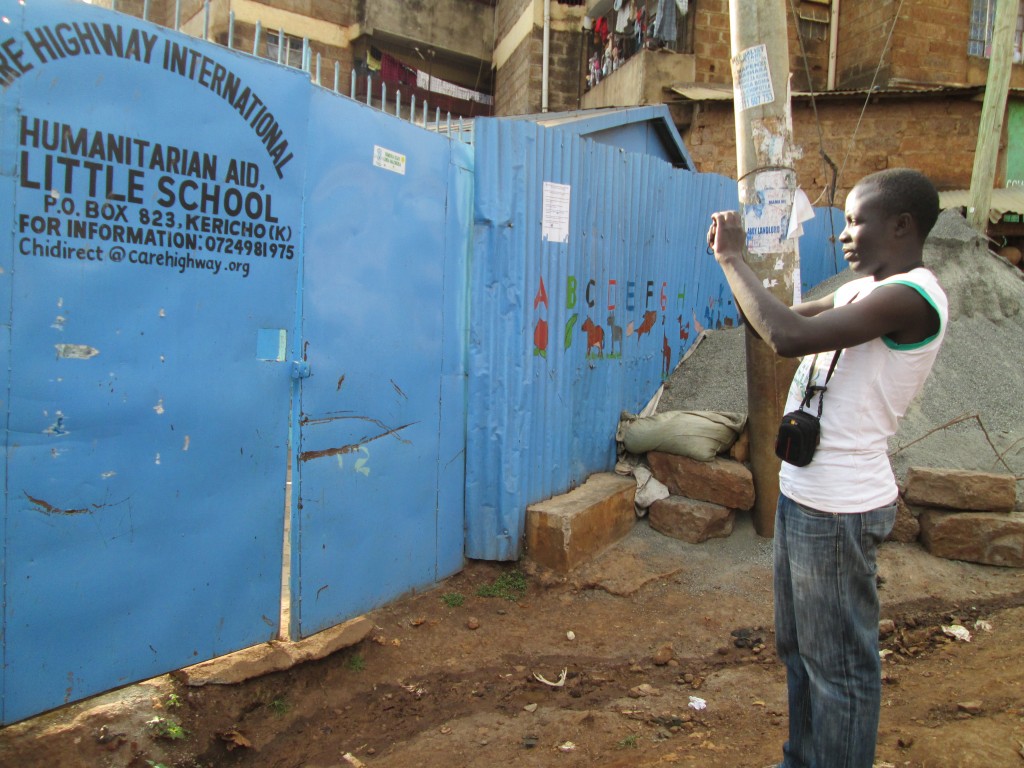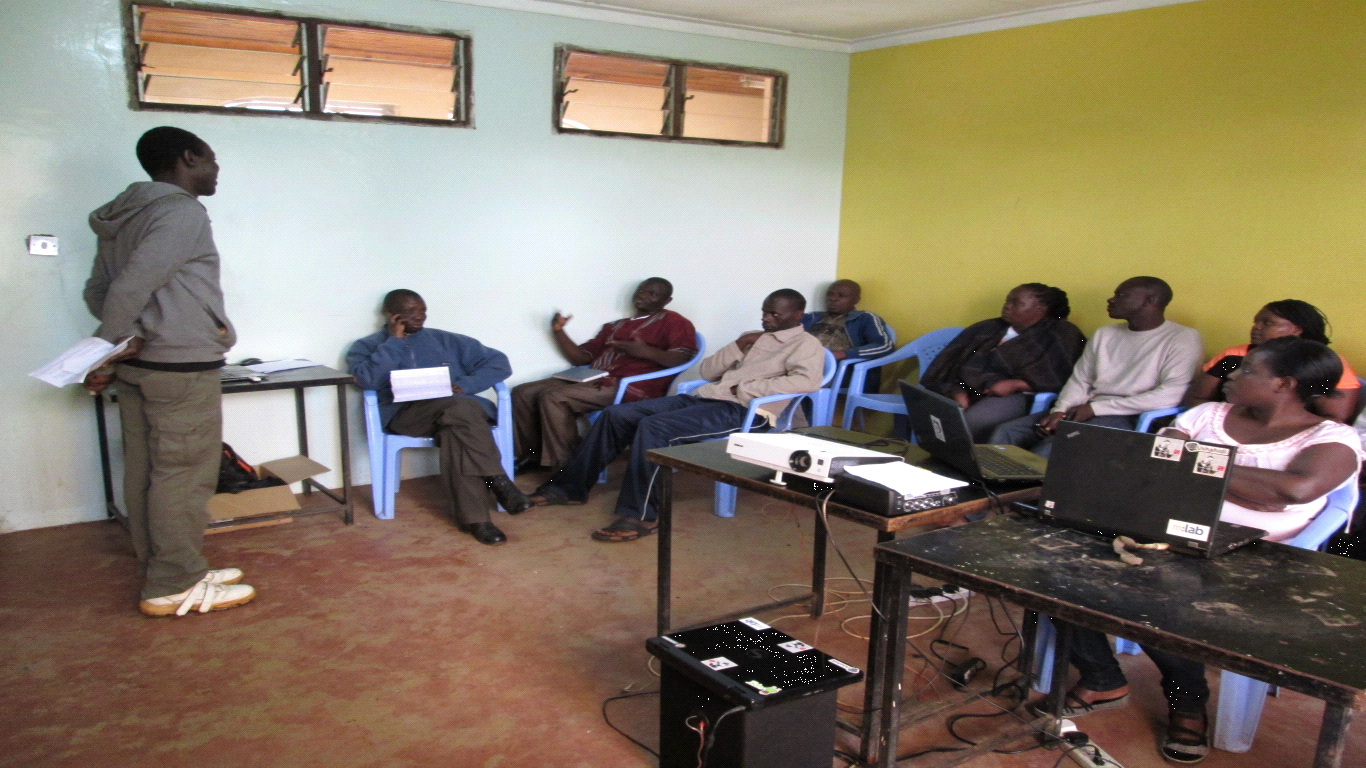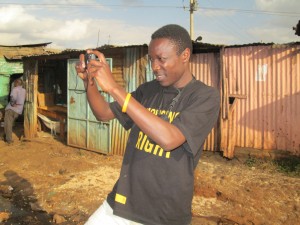The following article is by Professor Bitange Ndemo, former Permanent Secretary of Information and Communications, Kenya, who was largely responsible for Kenya Open Data‘s emergence in 2011. He is currently an Associate Professor at the University of Nairobi Business School. We were honored to have him in attendance at the launch of Open Schools Kenya in Nairobi on February 24. Following the event, Prof. Ndemo published this column in the Daily Nation newspaper, republished with permission:
 Speaking Truth and Unveiling Opportunity: How Map Kibera Brought Hard Facts to Bear
Speaking Truth and Unveiling Opportunity: How Map Kibera Brought Hard Facts to Bear
In the past week, I attended three unrelated conferences. If they had been mashed together, a ground-breaking innovation would have emerged.
The first meeting on Monday morning was the launch of school data by Map Kibera, an initiative to map Kibra (formerly known as Kibera) and make it easier for residents to locate social services.Â
On Wednesday morning, I chaired a session at a regional conference of postal organisations trying to find ways to cope with technology and save themselves from extinction. One of their needs is a postal address system to start home delivery of parcels in the growing e-commerce industry.Â
On Thursday afternoon I was giving a keynote speech to creative artists trying to find their role in the emerging digital space. Had we combined these conferences, the outcome would have been a better solution to the problems facing our country.
It emerged that all the three conferences needed a great deal of data if they were to succeed.
In Kibra, data was essential in engaging policymakers with hard facts. For example, data from the mapping shows that primary operators for Kibra schools include NGOs or CBOs at 37 per cent, private owners at 29 per cent, religious organisations at 27 per cent and government at 4 per cent.Â
So when the policy statement of the Education ministry on Form One admissions is biased towards government schools, they should understand who they hurt most.
Postal corporations need data on trade and movement of goods for better logistical planning. They also need ways of reaching customers wherever they are.Â
Finally, creative artists need data on media and entertainment consumption patterns as a basis for developing new business models and meeting customer demands. Â Â Â
Whilst Map Kibera has the perfect solution for Posta to reach people they have never reached before, Posta is hedging its bet on a policy process to allow them reach the unreachable.
TOILET-TO-PEOPLE RATIO
Let me confess that I started the process of street numbering with the hope of using Global Positioning System (GPS) in informal settlements. However, bureaucracy took many turns and by the time I was leaving, we had only covered the Central Business District (CBD).Â
My thinking was to create addresses for the entire country first, then create a law. However, that has changed. The law will be created first, before we create the addressing system. Innovation in my view precedes legislation.
Meanwhile, residents of Kibra and other marginalised areas are being taken advantage of by unscrupulous people. “They are stealing from the poor,†area MP Kenneth Okoth says.Â
The MP was particularly livid with Nicholas Kristof and Sheryl WuDunn’s latest book, A Path Appears: Transforming Lives, Creating Opportunity, in which he says numbers had been exaggerated to portray Kibra negatively.
The MP wondered what logic Kristof, a New York Times columnist, two-time Pulitzer Prize winner and co-author, used in stating that Kibra had a toilet-to-people ratio of 1:1,300.
The MP rightfully said that if that were to true, given that the entire day has 1,440 minutes, then every morning you would see queues of people waiting for their turn in the toilet, that they must use it very quickly indeed to enable others to use it.
Curiosity forced me to buy the book. It reads like a global green party manifesto, profiling social-justice individuals and groups, and describing concerns that range from environmental issues such as clean energy and reduction of deforestation to social issues such as battling foetal alcohol syndrome, sex trafficking, malaria, clubfoot, cleft palate, sexual assault against children and women, Aids, lack of potable water, illiteracy, child malnutrition and poverty.Â
OPEN DATA, OPEN SOURCE, OPEN ACCESS
In Kibra, they profile my friends, Kenneth Odede and Jessica Posner. Like many people before the census data came out to confirm the Kibra population, Kristof was largely relying on guesswork that later could be mistaken for exaggeration.
Anyone reading the book could perhaps criticise Kristof and WuDunn for neglecting to mention some of the prominent NGOs working to mitigate these maladies. They also fail to bring out the impact of climate change.Â
However, Mr Okoth and the co-authors Kristof and WuDunn agree that some of the resources meant for the poor get stolen. Indeed, if every shilling raised to alleviate poverty in Kibra were to be used for its intended purpose, every one of the close to 400,000 residents will be on a comfortable monthly salary for at least five years.
According to the Bible, God prohibited such theft in Proverbs 22:22-23 (KJV): “Rob not the poor, because he is poor: Neither oppress the afflicted in the gate. For the Lord will plead their cause and spoil the soul of those that spoiled them.”
But before God makes the sinners repay, we can prevent this through building open data platforms like Map Kibera.
Before I tell you more about what Map Kibera is and how it converges with Posta and the creative economy industry, let me first explain the concept of open data because it cuts across the interests of these three groups.Â
Open data is the idea that certain data should be freely available to everyone to use without any mechanisms of control. For example, information on who is providing social services to the poor, who funds such activities and how much is funded, should be in the public domain.Â
The goals of the open data movement are similar to those of other “open” movements such as open source and open access. It is critically important for stakeholders to know how much of the money raised for Kibra comes to Kibra.Â
Residents can also ask the right questions, for example, how much Constituency Development Fund (CDF) their MP received, and where it was spent.
PARCELS TO ‘UNREACHABLE PLACES’
Map Kibera was officially launched at Eastlands Hotel on Tuesday last week. The low-key event was witnessed by the area MP, Ken Okoth, Nairobi County Education Minister Christopher Khaemba, Erica Hagen of Groundtruth and many other dignitaries from Kibra. Â
The project originated with a winning entry to the Gates Foundation Grand Challenge pilot contest on data interoperability, early last year. Map Kibera was a key entrant with partners that included GroundTruth Initiative and Development Gateway. Â
Ms Hagen co-founded Map Kibera Trust in 2009 with her partner and a team of youths in Kibera, several of whom are still part of the Trust and worked on this project. GroundTruth Initiative was founded in 2010, also by Ms Hagen and partner Mikel Maron. Â
Hagen and Maron live in Washington, DC, and work through GroundTruth (a small consulting firm) to spread more globally the kinds of projects that Map Kibera has become known for, such as citizen-led mapping, data, journalism, etc. They also remain quite involved with Map Kibera itself.
We can now locate assets in Kibra through the generosity of the Gates Foundation and two dedicated Americans. It is incumbent upon us to make the project sustainable.Â
A private-public partnership with Posta could leverage this project to develop new businesses, while at the same time meeting postal objectives of universal service connectivity coverage.Â
Many of the youths in Kibra can become delivery agents using GPS to take mail and parcels to unreachable places. In similar fashion, the creative society could reach the poor and begin to tell their story through film and bring their plight to the sitting rooms of the rich as well as policy makers. It is an opportunity for the creative to locate the raw talent that lies in Kibra.
Many people like Kristof and WuDunn mean well when they highlight the problems of the poor and vulnerable. We must understand the dynamics of bad reporting on our status.Â
HIDING OUR FUTURE
We are partly to blame when we hide data from the public. There is nothing wrong in telling the world the number of the poor in our midst.Â
Data is the lifeblood of innovation. We curtail our own creativity and progress when we hide data. Data helps us shape policy to respond to human needs.Â
It is such an irreplaceable resource that in hiding it, we would be hiding our future from the pricking eyes of those coming after us.
I submit that Kibra is a problem that presents us with the opportunity to innovate and be part of a global solution in poverty reduction. In bringing together different players such as the ongoing National Youth Project on cleaning up Kibra and not just Posta and the creative sector, we shall be getting closer to a better solution to poverty reduction.
Henry Ford once said, “Coming together is a beginning; keeping together is progress; working together is success.â€


